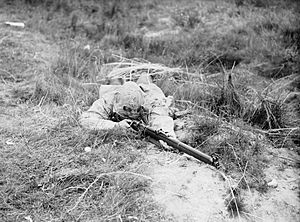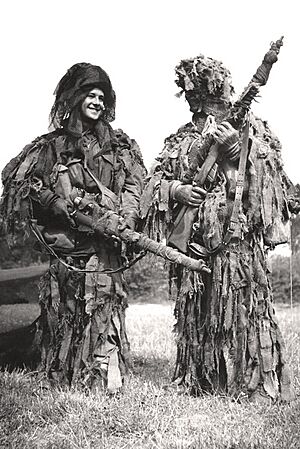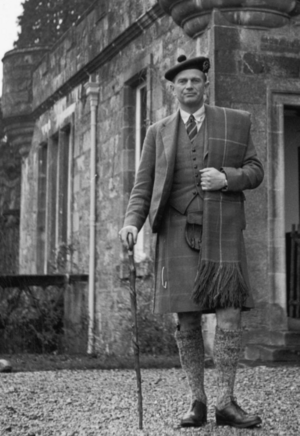Lovat Scouts facts for kids
Quick facts for kids Lovat Scouts |
|
|---|---|

Cap badge of the Lovat Scouts
|
|
| Active | 1900–present |
| Country | |
| Branch | |
| Type | Yeomanry |
| Size | 1900s: Two battalions World War I: Six regiments World War II: Two battalions |
| Motto(s) | Je suis prest (I am ready) |
| Battle honours | South Africa 1900–02 Gallipoli 1915 Egypt 1915–16 Macedonia 1916–18 France and Flanders 1916–18 |
| Commanders | |
| Notable commanders |
Simon Fraser, 14th Lord Lovat Simon Fraser, 15th Lord Lovat Donald Cameron of Lochiel |
The Lovat Scouts were a special unit of the British Army. They were first created in Scotland during the Second Boer War in 1900. This group was known for being the first military unit to wear a ghillie suit, which is a special camouflage outfit.
They were also famous for their amazing skills in finding out information about the enemy, a job called reconnaissance. In 1916, the Lovat Scouts officially became the British Army's first sniper unit, known back then as "sharpshooters." They bravely served in both the First World War and the Second World War.
History of the Lovat Scouts
How the Lovat Scouts Began
The Lovat Scouts were formed in January 1900. They were created by Simon Fraser, 14th Lord Lovat, who was the chief of a Scottish clan called Clan Fraser of Lovat. He wanted to help during the Second Boer War.
The first members of the unit were mostly gamekeepers and professional stalkers from the Scottish Highlands. These men were already very skilled at marksmanship (shooting), fieldcraft (moving secretly in nature), and military tactics (planning how to fight). They were also excellent at living and surviving in the woods. They had a saying: "He who shoots and runs away, lives to shoot another day."
The Lovat Scouts made history by being the very first military unit to use the Ghillie suit. This special suit helps soldiers blend in with their surroundings, making them almost invisible.
After the Second Boer War ended in 1902, the unit was reformed. From this group, a special "sharpshooter" unit was created. This unit officially became the British Army's first-ever sniper unit, focusing on precise shooting and observation.
Lovat Scouts in the First World War
When the First World War started in 1914, many members of the Lovat Scouts volunteered to serve overseas. Because of this, the units were split into different "Lines."
First Line: Fighting Overseas
The 1/1st Lovat's Scouts Yeomanry arrived in Gallipoli in September 1915. This was a very tough battle. Later, they moved to Egypt and then became part of the Queen's Own Cameron Highlanders regiment. They also served in Salonika (now Thessaloniki) and later in France.
Second Line: Home Defense and Cyclists
The Second Line regiments were formed in 1914 to help defend Britain. In 1916, these regiments were changed into cyclist units. This meant they used bicycles to move around quickly. They were part of the 1st Cyclist Division and were based in places like Somerleyton and Beccles in England.
Third Line: Training New Soldiers
The Third Line regiments were set up to train new soldiers. They provided replacements for the units fighting overseas. These training units were based in Beauly and Perth, Scotland. In 1917, their soldiers joined other units.
"Sharpshooters" and Snipers
In 1916, the Lovat Scouts created special groups called "sharpshooters." These groups were experts at observation and sniping on the Western Front. Their job was to gather information and take out important enemy targets from a distance. This made them very valuable.
Between the World Wars
After the First World War, many cavalry units were no longer needed. However, the Lovat Scouts were one of only two Scottish units that remained mounted as 'Scouts.' This showed how important their special skills were.
Lovat Scouts in the Second World War
From 1940 to 1942, the Lovat Scouts were stationed in the Faroe Islands. Their job was to protect these islands from a possible invasion by Nazi Germany.
Later, in December 1943, the regiment was sent to Canada for special training. They traveled by ship and then by train across Canada to Jasper, Alberta. Here, in Jasper National Park, they learned important skills for fighting in cold, mountainous areas.
- Ski Training: They started with basic ski training, focusing on cross-country skiing while carrying heavy gear like sleeping bags, food, and rifles.
- Survival Skills: They learned how to survive in very cold conditions. This included digging snow holes to sleep in and building simple shelters from trees.
- Mountain Climbing: They practiced climbing on snow and ice, using tools like ice axes and crampons.
The soldiers spent weeks in remote parts of Jasper National Park, practicing their survival skills on expeditions. They would often sleep in snow holes. When they weren't training, they lived in large canvas tents with wood-burning stoves to keep warm.
After their intense training in Canada, the Lovat Scouts sailed back to Britain. They then traveled to Italy in July 1944. There, they took part in the rest of the Italian campaign, fighting until Germany surrendered in May 1945.
After the Second World War
After the war in Europe ended, the Lovat Scouts moved into Austria and Bavaria. Their mission was to find important members of the Nazi party and SS personnel. In early 1946, they flew to Greece to help during a civil war there.
Over the years, the Lovat Scouts unit changed its role and name several times. It became part of different artillery and anti-aircraft regiments. Eventually, it was reorganized into smaller platoons within other Scottish regiments.
The legacy of the Lovat Scouts is still kept alive today by the Orkney and Shetland Battery of the 1 Highlanders Battalion Army Cadet Force. Members of this cadet unit are still allowed to wear the special headwear and tartan of the Lovat Scouts.
Music
There is a lively Scottish tune called The Lovat Scouts. It's a quickstep and strathspey, written for bagpipes by James Scott Skinner.
Memorials
You can find a memorial dedicated to the Lovat Scouts in the town square of Beauly, Inverness, Scotland.
See also
- Imperial Yeomanry
- Yeomanry
- Queen's Own Cameron Highlanders
- Commandos (United Kingdom)







